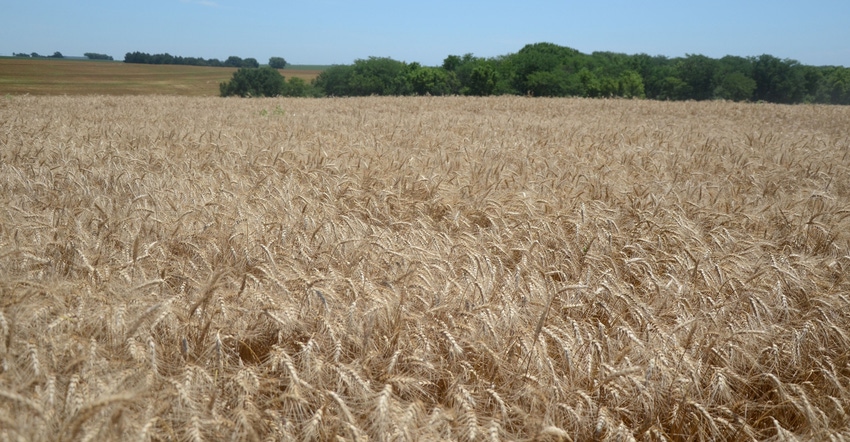March 7, 2018

We’ve written before in Resilient Ag Landscapes columns about the “whole-system approach” to crop rotations — whether that includes cover crops, no-till practices or various crops in the rotation.
Oftentimes, this means a benefit that isn’t quite as tangible as yield, although still economically beneficial — usually an increase in organic matter, infiltration, weed suppression and erosion control. These benefits may show up after the first year, or may take shape after five to 10 years. However, there are cases where a crop rotation directly results in a yield boost to the following crop. In these cases, it’s important to remember which crop deserves that credit for that yield boost.
Paul Hay, retired Nebraska Extension educator in Gage County, collected survey data for 11 years from 1994 to 2005 on crop rotation practices in southeast Nebraska, and found a yield boost to the following corn crop from wheat.
“If you compare corn planted on soybean ground, which would be the typical rotation, and look at corn planted on wheat ground on dryland southeast Nebraska, you’re at about a 20-bushel-per-acre advantage for corn planted into wheat,” Hay says. “That’s also true for grain sorghum.”
Research from the Oklahoma Panhandle Research and Extension Center in 2001, 2002 and 2004 shows a yield boost to corn following grain sorghum, with corn planted after grain sorghum yielding 20 to 30 bushels more per acre than continuous corn in an irrigated environment.
In both cases, the likely reason is due to moisture retention with cooler soils and greater amounts of residue in milo and wheat stubble. Especially with wheat, there’s less water used late summer compared to soybeans, leaving more water for the following crop.
“Generally, when you grow wheat, the following crop will have more subsoil moisture because you didn’t have something using water in the month of July and August like you would corn and especially soybeans,” says Nathan Mueller, Nebraska Extension cropping systems educator in Dodge and Washington counties.
In the central and eastern Corn Belt, Mueller notes there is still a benefit, although not due to moisture retention.
A study conducted by the University of Illinois in Monmouth, Ill., from 1998 to 2014 found an increase of 9 to 10 bushels per acre on no-till corn yields by going from a soybean-corn rotation to a soybean-wheat-corn rotation and a wheat-soybean-corn rotation, respectively. Meanwhile, no-till soybean yields increased 3 to 4 bushels per acre by going from a corn-soybean rotation to wheat-corn-soy and corn-soy-wheat.
“That’s worth penciling in,” Mueller says. “If we think there are yield advantages by adding a third crop, we should attribute that yield advantage to the crop it’s coming from. So, if you get 3 to 4 bushels more yield in soybean from a wheat rotation, it’s important to attribute that to the wheat crop, which means you move that back in time on the balance sheet. Four bushels times $10 — that’s $40 that wheat crop made you, which is the way I’d like people to think about their wheat crop.”
In western Illinois, where annual rainfall totals typically reach more than 35 inches, these yield improvements are more likely due to a reduction of overall disease inoculant in the soil, a reduction in soybean cyst nematode and other pest or disease cycles that are broken up by adding a third crop to the rotation.
Especially in climates that are drier, Paul Jasa, University of Nebraska Extension engineer, notes it’s important to include the right crops in the rotation.
Research conducted by Dwayne Beck, research manager of the Dakota Lakes Research Farm in Pierre, S.D., tested a four-crop rotation, including two legumes and two grasses — soybeans to corn to field peas to winter wheat. However, he found this rotation didn’t have enough carbon.
“When he had that four-crop rotation, his wheat yields were 28 to 29 bushels in a poor year, and 57 in a good year. When he took soybeans out of the rotation and went to corn-peas-wheat, the 29 and 28 bushels per acre became 56, and 57 bushels per acre became 92. On the poor years, he more than doubled the wheat yield by having higher carbon,” Jasa says. “That’s one reason I like adding wheat into the rotation. It’s high carbon. It’s growing in the off season to help build the system.”
There are hurdles to expanding the rotation beyond corn and soybeans, including crop insurance and whether the farm ground is owned or rented, Hay notes.
“You’ve got to remember that 60% of the land farmed in southeast Nebraska is rental property. How do I look at yield, gross income, etc., on wheat and compete on paying rent? That’s a factor,” Hay says. “The farmer that owns the ground he farms and looks at his whole farm revenue and not just crop revenue, he’ll realize the benefit from that.”
You May Also Like




